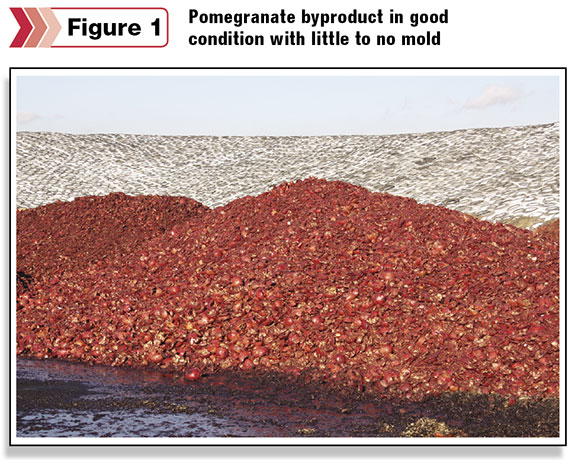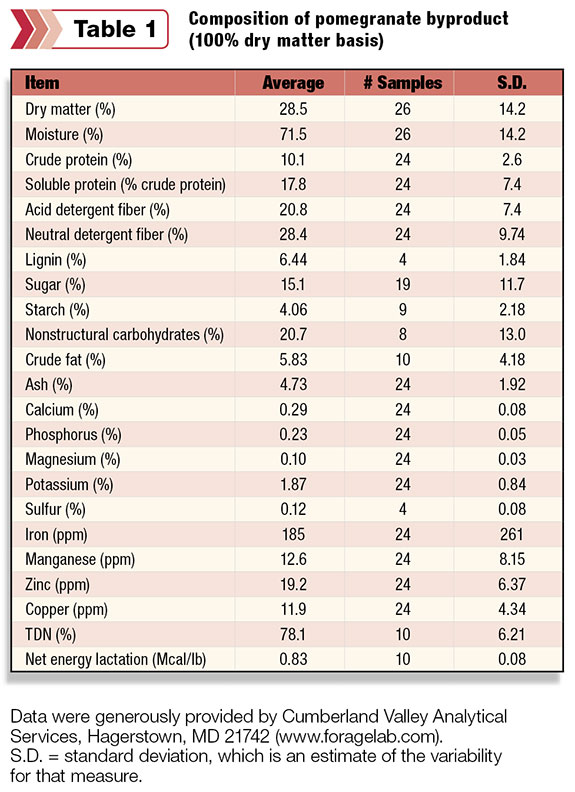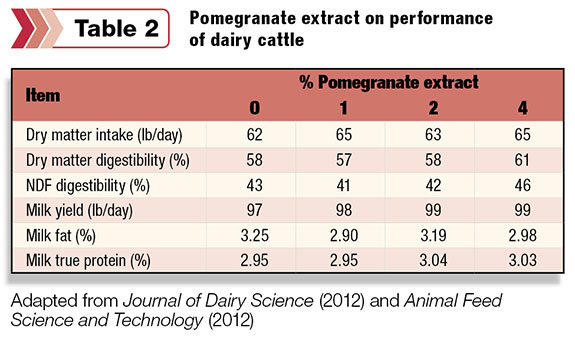The pomegranate (Punica granatum L.) is a fruit that belongs to the Punicaceae family. A University of Georgia extension publication indicates that its Latin name means “seeded apple.” Pomegranate consumption by humans has increased in recent years because of its purported health benefits.
The polyphenols, ring structures in pomegranate juice, possess antioxidant and anti-inflammatory properties associated with potential beneficial health effects against certain diseases, although the research is still incomplete on the health aspects.
Google pomegranate and you will find interesting facts: For example, carbon traces of the fruit were found in pottery back in the Early Bronze Age. The fruit and bark of the pomegranate tree were used for centuries to treat diarrhea, dysentery and intestinal parasites.
An interesting article suggested that the forbidden fruit that Eve ate in the Garden of Eden was not an “apple” as we think of an apple, like a Red Delicious, but a pomegranate (“seeded apple”).
Two recent events stimulated our writing this article about pomegranate byproduct. Recently a colleague asked if feeding pomegranate waste to cows could be responsible for milkfat depression on a dairy farm because of the lipid in the pomegranates.
The second was the death of cows on a dairy that was linked to feeding moldy pomegranate waste, although this has yet to be proven.

Pomegranate grows well in California. The juice of pomegranates is high in antioxidants (polyphenols). With the increased popularity of pomegranate juice, more pomegranates are used for juice production.
A byproduct of juice production is pomegranate peel or waste – an inedible product to humans (see Figure 1 ).
There is no consistent name for the byproduct, so we called it pomegranate byproduct unless it was called something different in a research report.
A general composition of pomegranate

byproduct is presented in Table 1 , although as shown by the standard deviation estimate, there is considerable variation for the 26 samples in the data set.
From an animal nutrition point of view, pomegranate byproduct contains protein, carbohydrates, lipids, vitamins, minerals and water – all nutrients that can be used by dairy cattle.
Pomegranate byproduct is low in protein (10 percent). Even though most of the sugar is extracted with the juice, there is a fair amount of sugar remaining (15.1 percent) with a wide range in sugar content based on the large standard deviation.
The sugar content will vary depending on the amount of whole fruit in the byproduct. Pomegranate peel was reported to be a good source of vitamin E (γ-tocopherol form) for livestock.
Pomegranate peels were reported to contain tannins and other polyphenolic compounds.
High levels of tannins can have detrimental effects on animal health. There are water-soluble and lipid-soluble polyphenolic compounds, although the majority appear to be water-soluble.
Peels when exposed to sun, moisture and air were reported to be “susceptible to fungal fermentation and microbial attack.” Researchers demonstrated degradation of condensed and hydrolyzable tannins by a fungal strain.
Mold growth can be an issue with pomegranate byproduct because molds (fungi) produce mycotoxins that can have harmful effects when consumed by cattle as well as most animals.
One research study looked at methods of storage for pomegranate byproduct using laboratory-scale techniques that included drying, cold temperature and ensiling.
The pomegranate byproduct contained less than 20 percent dry matter, so the ensiling process had large effluent losses that impacted silage composition.
Much more research needs to be conducted on storage methods. If fresh pomegranate byproduct is not fed rapidly on dairy farms, it will deteriorate.
Why is pomegranate byproduct often brown in color? The browning of pomegranate byproduct is likely linked to enzymatic action. There is an enzyme in many plants called polyphenol oxidase.
One report indicated that under aerobic conditions (presence of air), this enzyme converts polyphenol compounds in the pomegranate peel to quinone compounds, which polymerize, forming a brown pigment. This might explain the dark color sometimes observed with pomegranate byproduct.
So how might tannins impact dairy cattle? Tannins are unique compounds in plants that have both positive and negative effects. Tannins are often thought to be antiherbivory – deterring the animal from eating the plant.
Tannins possess astringent properties. Eat a green, unripe apple, and the tannins cause a puckering sensation in your mouth (astringent property).
Many browsing animals, for example the moose, evolved to produce tannin-binding proteins in their saliva to bind plant tannins and allow the moose to eat those plants.
Tannins also bind proteins. In the plant it is thought that this protects the plant from some insect attack. The tannins bind enzymes, which are proteins secreted by the insect, and this protects the plant against being degraded by insect enzymes.
Tannins can also bind proteins in the digestive system of dairy cattle and reduce digestibility of dietary protein and starch. Plus, if tannins are absorbed from the digestive tract in high amounts, they can cause metabolic problems for the animal.

The research on pomegranate byproduct for dairy cattle is limited.
In two recent papers from the same research group, a pomegranate extract was fed to lactating dairy cows ( Table 2 ).
The pomegranate byproduct remaining after juice production includes the peel, any remaining seeds with pulp (seeds are called arils) and inner parts of the fruit.
The pomegranate byproduct in this research was extracted with water, concentrated and added to the diet. We are not trying to be overly critical of the research project because there is no perfect study conducted, but we are trying to stimulate thought.
The researchers added the pomegranate extract to a base TMR at 0, 1, 2 and 4 percent of the diet dry matter, although we will only discuss the 0 and 4 percent treatments since these were different at times.
There were positive effects at the 4 percent inclusion of the extract including increased dry matter intake, increased milk protein, increased digestibility of dry matter and neutral-detergent fiber, and a slight increase in milk yield compared with the 0 percent extract diet.
There was no detrimental effect of tannins and other polyphenolic compounds on dry matter intake, so that is positive.
The authors attributed the increased milk protein from 2.95 percent on the control (0 percent extract) to 3.03 percent protein on the 4 percent extract diet to a beneficial effect of tannins binding protein in the rumen to provide a bypass source of protein to be used for milk synthesis.
Another possible explanation might be that the pomegranate extract they used contained 28.8 percent sugar, so cows were fed three-quarters of a pound of sugar. Sugar is highly fermentable by rumen microbes, providing energy for their growth.
At UC – Davis, we demonstrated years ago that increasing carbohydrate digestion in the rumen, for example feeding steam-flaked corn, increased milk protein. Most nutritionists know that if you increase the concentrate portion of the diet, milk protein often increases.
The reason why is not completely understood, but feeding something like sugar or steam-flaked corn will likely increase microbial growth in the rumen so that more microbial protein is produced, and this protein when digested in the small intestine supports higher milk protein synthesis.
This is a positive situation since less nitrogen (protein contains nitrogen) is lost in the urine and more nitrogen is captured in microbial protein and eventually milk protein.
The researchers also reported that milkfat decreased from 3.25 percent for 0 percent extract diet to 2.98 percent for the 4 percent extract diet. The classical milkfat depression studied in the 1950s and 1960s was associated with high-carbohydrate diets.
Granted, one could argue that even the control diet with its 3.25 percent milkfat is actually a milkfat-depressed situation, and that would be a good point. But it is quite probable that the sugar intake from the pomegranate extract depressed milk fat synthesis.
The three-quarters of a pound of sugar consumed by the cows was only about 1 percent of the diet. But any change in the diet impacts the rumen microbes.
In fact, these researchers found that bacterial populations did change. With the 4 percent extract diet, bacterial populations that ferment sugar increased while those that ferment cellulose (fiber) decreased.
These changes in microbial populations support the lower milkfat percent and milkfat yield that occurred on the 4 percent extract diet.
The fact that these researchers measured bacterial populations is fantastic because the data help to understand what was is happening.
Since the bacteria that digest cellulose (fiber) decreased with the 4 percent pomegranate extract, how can fiber (NDF) digestibility increase?
The researchers measured digestibility using a marker approach, often called the indirect method – indirect because grab-samples of the feces were collected instead of collecting all of the feces (total collection).
It is extremely difficult to do total fecal collection with dairy cattle, so the indirect method (grab-samples) is probably the better approach.
The issue is that the researchers allowed the cows to have 5 to 10 percent feed refusal. Basically, if you look at the formula to calculate digestibility using the indirect method, you cannot have feed refusal. The cows have to eat the entire diet because the marker is a constituent of the diet.
Cows sort, so a marker like indigestible NDF has issues when there are feed refusals. That is why doing digestion studies on commercial dairy farms yields little meaningful data when cows are group-fed unless the marker consumption is controlled.
It is possible that a marker error attributed for the higher NDF digestibility with the 4 percent extract diet compared with the 0 percent diet, particularly since the two intermediate diets (1 and 2 percent extract) were numerically lower in NDF digestibility than the 0 percent extract diet.
It is also possible that the authors of the research are dead-on correct that the 4 percent pomegranate extract increased fiber digestion. We do not know, and that’s why we do research.
So what about the possibility of the lipid in pomegranate byproduct contributing to low milkfat? It is possible. Unsaturated fatty acids impact the rumen microbes and do contribute to milkfat depression.
This can happen at times with feeding high levels of distillers grains that contain considerable amounts of corn oil.
But based on what the research above found for milk protein and bacterial population shifts, and the composition data in Table 1, sugar looks like a better reason than lipid.
We analyzed one sample of pomegranates purchased from a grocery store. The entire pomegranate was ground for analysis and was found to contain 57.1 percent sugar and 1.2 percent starch, so the nonstructural carbohydrate content was 58.3 percent.
Total fatty acid content was low – less than 1 percent. We also found less than 1 percent total fatty acids in the moldy pomegranate byproduct.
The major fatty acids in the whole pomegranate were similar to those present in the moldy pomegranate, with about 18 percent palmitic acid (C16:0), 25 percent oleic acid (C18:1), 32 percent linoleic acid (C18:2) and 3 percent alpha-linolenic acid (C18:3).
If the pomegranate byproduct contains whole fruit as seen in Figure 1, then the sugar content will be affected, and this could impact both rumen fermentation and milk composition.
Pomegranate byproduct is like many other feedstuffs, inedible to humans after its original use for production of human food.
Pomegranate byproduct has a wide assortment of nutrients that support productive purposes in dairy cattle. The fact that dairy cattle convert this human-inedible byproduct into human-edible milk and meat is positive for agriculture.
To date, we are unaware of any research conducted in California on feeding pomegranate byproduct to dairy cattle. If we missed something, let us know.
However, based on the limited published data and because of the tannins and other polyphenolic compounds and the potential for mold growth, further metabolism studies should be conducted with pomegranate byproduct.
Take-home message
Pomegranate byproduct has a wide assortment of nutrients that support productive purposes in dairy cattle. However, pomegranates contain tannins and other polyphenolic compounds that at some unknown levels might have negative effects on animal performance.
The level of feeding is important, and that is what the skilled nutritionist determines.
Storage of pomegranate byproduct is also an issue because the sugar is readily available to bacteria and fungi to support their growth when there is adequate air, moisture and heat present.
Fungi (molds) produce mycotoxins, and these can have harmful effects on animals. It is important to minimize spoilage of pomegranate byproduct that is fed to dairy cattle.
Pomegranate byproduct, when properly stored and when included in a balanced diet, is a very good byproduct feedstuff.






